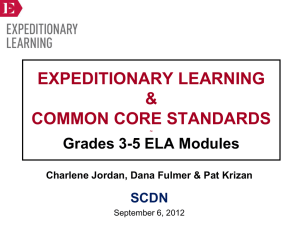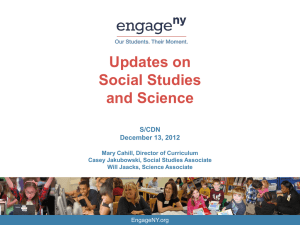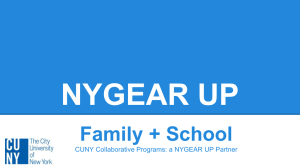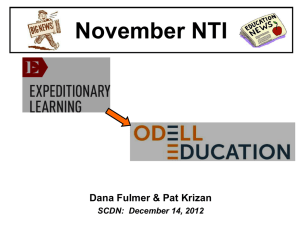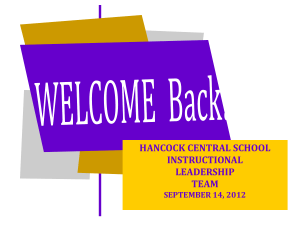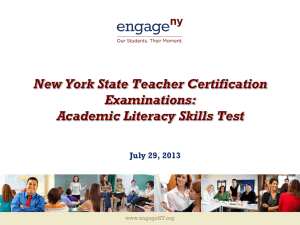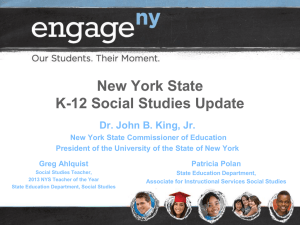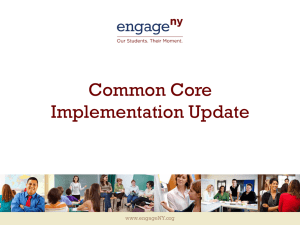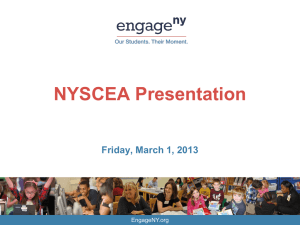Wagner_Ken_NYSCEA_5-16
advertisement
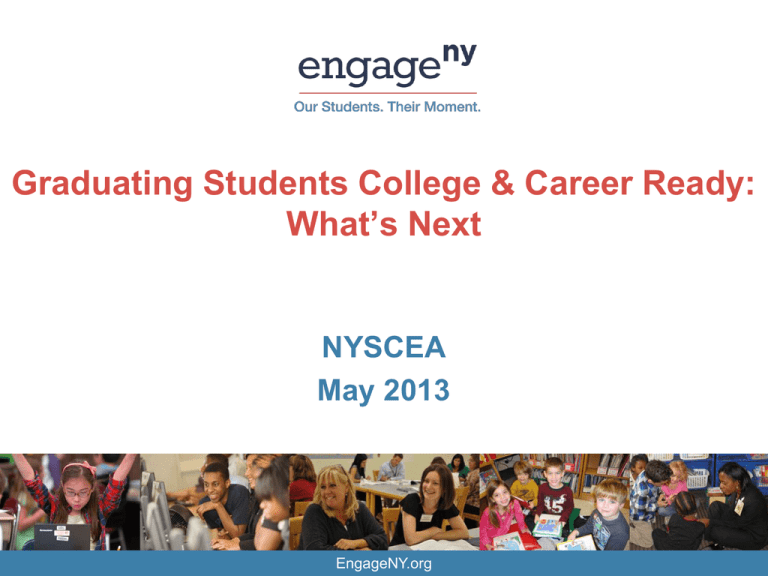
Graduating Students College & Career Ready: What’s Next NYSCEA May 2013 EngageNY.org Graduating College and Career Ready New York's 4-year high school graduation rate is 74% for All Students. However, the percent graduating college and career ready is significantly lower. June 2011 Graduation Rate Graduation under Current Requirements Calculated College and Career Ready* % Graduating % Graduating All Students 74.0 All Students 34.7 American Indian 59.6 American Indian 16.8 Asian/Pacific Islander 82.4 Asian/Pacific Islander 55.9 Black 58.4 Black 11.5 Hispanic 58.0 Hispanic 14.5 White 85.1 White 48.1 English Language Learners 38.2 English Language Learners 6.5 Students with Disabilities 44.6 Students with Disabilities 4.4 *Students graduating with at least a score of 75 on Regents English and 80 on a Math Regents, which correlates with success in first-year college courses. Source: NYSED Office of Information and Reporting Services EngageNY.org 2 College Remediation in NYS Over 50% of students in NYS two-year institutions of higher education take at least one remedial course. Remediation Rates for First-time, Full-time Undergraduates 60.0% 50.0% 2004-05 2005-06 2006-07 2007-08 2008-09 2009-10 40.0% 30.0% 20.0% 10.0% 0.0% All Institutions 2-Year Institution 4-Year Institution Source: NYSED Administrative Data for all Public, Independent and Proprietary 2- and 4-year institutions of higher education EngageNY.org 3 Children of College-Educated Parents Percent of 15-Year-Olds Proficient in Math 80% 75% 70% 60% 50% 50% 42% 40% 30% 20% 10% 0% United States Canada Shanghai Source: Levine, Arthur. “The Suburban Education Gap.” The Wall Street Journal. 2012. http://online.wsj.com/article/SB10000872396390444223104578041181255713360.html EngageNY.org 4 Underperformance Costs $1 Trillion • America’s urban school districts underperform compared with their suburban counterparts. • America’s suburban school districts underperform compared with their international counterparts. Very few American suburban students outperform their counterparts in Finland and Singapore, two of the world’s top school systems. • If American students performed at the same level in math as Canadian students, we would add $1 trillion annually to the economy. Source: Levine, Arthur. “The Suburban Education Gap.” The Wall Street Journal. 2012. http://online.wsj.com/article/SB10000872396390444223104578041181255713360.html EngageNY.org 5 Talent Dividend If New York increased its college attainment rate by just one percent – from 33.8 to 34.8 percent – the region would capture a $17.5 billion Talent Dividend. Source: CEOs for Cities: http://ceosforcities.org EngageNY.org 6 Labor Market Has Become More Demanding A post-secondary education is the “Passport to the American Dream”: Of the projected 47 million job openings between 2009-2018, nearly two-thirds will require workers to have at least some post-secondary education. 14 million job openings will go to people with an associate’s degree or occupational certificate and pay a significant premium over many jobs open to those with just a high school degree. Sources: Pathways to Prosperity Project, Harvard University, February 2011; Georgetown Center on Education and the Workforce, Help Wanted: Projections of Jobs and Education Requirements Through 2018, June 2010. EngageNY.org 7 Pathways to Prosperity “…tonight I ask every American to commit to at least one year or more of higher education or career training. This can be community college, a four-year school, vocational training, or an apprenticeship. But whatever the training may be, every American will need to get more than a high school diploma.” - President Obama’s address to a Joint Session of Congress February 24, 2009 Source: Pathways to Prosperity Project, Harvard University, February 2011, http://www.gse.harvard.edu/news_events/features/2011/Pathways_to_Prosperity_Feb2011.pdf EngageNY.org 8 Regents Reform Agenda Implementing Common Core standards and developing curriculum and assessments aligned to these standards to prepare students for success in college and the workplace Highly Effective School Leaders Highly Effective Teachers College and Career Ready Students Building instructional data systems that measure student success and inform teachers and principals how they can improve their practice in real time Recruiting, developing, retaining, and rewarding effective teachers and principals Turning around the lowestachieving schools EngageNY.org 9 What is the Work? Implementing the Common Core Instructional Shifts Demanded by the Core 6 Shifts in ELA/Literacy Balancing Informational and Literary Text Building Knowledge in the Disciplines Staircase of Complexity Text-based Answers Writing from Sources Academic Vocabulary 6 Shifts in Mathematics Focus Coherence Fluency Deep Understanding Applications Dual Intensity EngageNY.org 10 EngageNY.org Resources for Professional Development New and updated Parent and Family Resources Most relevant and current information, and newest materials highlighted for easy access. One-stop location for resources and materials to support implementation of the Regents Reform Agenda EngageNY.org 12 Facts and Figures To date, there have been over 14.8 million page views since August 2011… …and over 1.4 million unique visitors to EngageNY.org EngageNY.org 12 Tri-State Rubrics – Math & ELA Literacy EngageNY.org 13 NYS Curriculum – 1st and Only • Exemplary, comprehensive, optional, free • High-quality, rigorous, deeply aligned to the Common Core • Addresses needs of students performing above and below grade level, students with disabilities, and English language learners • Includes performance tasks and other assessments which measure student growth – daily, weekly, at the end of each unit/module • Ensures diversity of voices and perspectives in text selection • Contains notes for teachers, templates, handouts, homework, problem sets, overviews • Innovative creative commons license approach EngageNY.org 14 Curricular Resources • Professional Development Videos developed with authors of Common Core and PBS • Tri-State Rubric developed with Massachusetts and Rhode Island to evaluate district curricular materials against the Common Core • Content Frameworks developed by PARCC in collaboration with the authors of the Common Core • Curricular Exemplars (sample lessons and instructional materials) developed with feedback from the authors of Common Core • Sample Assessment Items developed with feedback from the authors of Common Core • Network Team Institutes / Teacher & Principal Common Core Ambassadors Program EngageNY.org 15 15 Sample Common Core Curricular Resources on EngageNY.org Visual blocks help educators navigate through various units within a module Common Core Standards are also highlighted There are downloadable resources at every layer EngageNY.org 16 Network Team Institutes Professional Learning Experiences for: • • • • Teacher and Principal “Ambassadors” District Staff Coaches Network Teams EngageNY.org 17 Changes to Common Core Grades 3-8 ELA and Math Tests • Beginning with the current school year (2012-13), we are re-designing our assessment program to measure what students know and can do relative to the grade-level Common Core. Specific changes to the Grades 3-8 ELA and math tests include the following: • Increases in Rigor – The CCSS are back-mapped, grade-by-grade, from college and career readiness. Many of the questions on the Common Core assessments are more advanced and complex than those found on prior assessments that measured prior grade-level standards. • Focus on Text – To answer ELA questions correctly, students will need to read and analyze each passage completely and closely, and be prepared to carefully consider responses to multiple-choice questions. For constructed response items, students will need to answer questions with evidence gathered from rigorous literature and informational texts. Some texts will express an author’s point of view, with which not all readers will agree. • Depth of Math – Students will be expected to understand math conceptually, use prerequisite skills with grade-level math facts, and solve math problems rooted in the real-world, deciding for themselves which formulas and tools (such as protractors or rulers) to use. EngageNY.org 18 Assessment Resources on EngageNY.org • Test Guides One for each grade and subject • Sample Questions Annotated for educator use in classroom • Assessment design criteria Passage-selection criteria Design criteria for Common Core questions New York State has never been more transparent about what content and skills are measured on our assessments… and how they are measured. EngageNY.org 19 Tests are Signals, Not the Curriculum Curriculum and Instruction reflect our real aspirations for our students • Take stock of our curriculum ELA resources (text, evidence) Math resources (depth, applications) • How do the State’s supplemental modules fit or not fit into local curriculum strategies? • How do we use video to reflect on practice? • How do we organize teacher time (review of student work, observation of colleagues)? • How do we organize principal time (time spent in classrooms)? EngageNY.org 20 Tests are Signals, Not the Professional Development • Do our APPR plans reflect the Common Core and College and Career Readiness? • Do our SLO’s reflect the Common Core and College and Career readiness? Did we pick the right targets? Did we pick the right measures? Do we need pre/post measures or is prior achievement sufficient? • Do our local achievement measures reflect the Common Core and College and Career readiness? • Do our summer and year-long PD plans reflect the Common Core and College and Career readiness? EngageNY.org 21 Career-Focused Pathways Career-focused pathways must span the last years of high school and at least one year of postsecondary education or training and lead to an industryrecognized credential. Key Challenge: To build enough differentiation in grades 11 and 12 that young people opting for occupations that require less formal academic training can take the initial steps toward viable careers. Source: Pathways to Prosperity Project, Harvard University, February 2011, http://www.gse.harvard.edu/news_events/features/2011/Pathways_to_Prosperity_Feb2011.pdf EngageNY.org 22 What is College and Career Readiness? • There is no common definition or one single measure of college and career readiness. • Research suggests: Sources: College and career readiness is defined by the content knowledge, skills, and habits that students need to be successful after high school whether in postsecondary education or training that leads to a career pathway. ACT. (2006); Conley, D. (2007); Conley, D. (2012). EngageNY.org 23 Career Readiness for All Students College Ready Career Ready High School Work Ready EngageNY.org 24 Domains of College and Career Readiness Defines the academic knowledge and skills students need to be successful in college and careers. Specifies the noncognitive, socio-emotional knowledge and skills that help students successfully transition from high school to college or careers. Describes the careerspecific opportunities for students to gain the knowledge, skills, and competencies they need to pursue and succeed in their chosen career. EngageNY.org 25 Measuring CCR today in NYS Aspirational Measures on New York State Regents Exams NY Graduates are College and Career Ready NY HS Grads can enroll and succeed in entrylevel, credit-bearing college courses in their 1st semester and/or embark on a career pathway 26 Evolving CCR Measures: Aspirational Performance Measures • New York developed alternative measures of student readiness based on research predicting likelihood of success in postsecondary education. Regents Diploma with Advanced Designation • Earn 22 units of credit, score at or above 65 on 7-9 Regents examinations, and take advanced course sequences in languages other than English, CTE, or the arts. ELA/Math APM • Graduate with a Local, Regents, or Regents with Advanced Designation diploma and earn a 75 or greater on their English Regents examination and earn a 80 or greater on a math Regents examination. EngageNY.org 27 Measuring CCR with PARCC • The Partnership for Assessment of Readiness for College and Careers (PARCC) Assessments will assess the Common Core standards in ways that require a broader range of skills needed to be CCR. Will include Performance-Based Assessments that measure reading comprehension, problem solving, and applying skills, concepts and understandings. Will use empirical evidence to set performance standards, building on methods used in New York in 2010 • Robust engagement strategies with higher education ensure that faculty across New York provide input into the development of CCR policy decisions and assessments. EngageNY.org 28 Academic Readiness: Beyond State Assessments • Advanced coursework and non-state assessments Academic readiness can also be measured by indicators such as: • • • • Performance on other assessments (SAT, ACT, AP exams) Advanced coursework such as AP and IB Performance on industry-certified exams Success in entry-level coursework • SED will begin to collect and report more data needed for a broader definition of academic readiness. EngageNY.org 29 Beyond Academic Readiness: Key Attitudes and Behaviors • Research widely recognizes that readiness for college and career extends beyond academic skills and achievements to non-cognitive and transitional skills. Such as: - Persistence - Resiliency - Goal Setting - Academic Behaviors like Study Skills - College Awareness - Career Awareness • These attitudes and behaviors are harder to measure, but SED will encourage early efforts and consider how to shape consistent, statewide approaches. EngageNY.org 30 Beyond Academic Readiness: Career-Specific Knowledge & Skills • These skills refer to those that are necessary for students’ success in their careers whether they enter these careers immediately from high school or after college. May include technical skills for a trade or manufacturing career or academic skills for careers in research, medicine, or law. • New York’s CTE course sequences increasingly lead to postsecondary enrollment or to direct entry into meaningful careers. EngageNY.org 31 Progress Reports on College and Career Readiness • SED will begin to report multiple indicators of college and career readiness on low-stakes reports for districts and high schools. • They will be designed for use by districts and schools to identify areas for improvement in the school's educational program to address students' readiness for college and careers. EngageNY.org 32 Sample High School High School Report 1. Select Graduation Cohort: 3. View Outcomes by Comparison Group This report provides information about your former high school students’ outcomes at CUNY. You can use the fields to the right to select a 4-year graduation cohort as well as subpopulations to compare. To see additional subpopulations, click on the "Data" tab. I (2007) I (2007) (outcomes presented are for graduates with these characteristics): 2. Select Comparison Group: All Students Ethnicity All Students Your School Note: Results representing few er than 5 students are suppressed. City CUNY Profile of 4-Year Graduates by Comparison Group (May not add to 100% due to missing data or rounding) 2007 4-Year Graduates # Grad Rate 603 71.1% THEN 603 4-year graduates in 2006-2007 72% 43% % Enrolled at CUNY in Fall 2007 % Enrolled in BA % Enrolled in AA at at CUNY CUNY 53% 47% 39% 29% % Enrolled at CUNY in Fall 2007 % Enrolled in BA % Enrolled in AA at at CUNY CUNY Percent of 2007 4-Year Graduates Enrolled at CUNY Who Required Remediation* NOW CUNY Outcomes 8% Reading 15% 8% Writing Math 22% Any 17% Reading 27% Writing 30% Math 45% Any Average Performance of 2007 4-Year Graduates in the Fall 2007 Semester at CUNY 260 4-year graduates in 2006-2007 who enrolled at CUNY in Fall 2007 All Students GPA Credits Earned Credits Attempted % Credits Passed 2.93 11.5 12.7 90% All Students GPA Credits Earned Credits Attempted % Credits Passed 2.62 9.3 10.7 87% *Note on Remediation: Students who require remediation are not fully prepared for college and must take (and pay for) remedial courses for which they receive no credit. Citywide, these students on average accumulate fewer credits, have lower persistence, and lower GPAs. For the years represented in this report, CUNY's proficiency standards required: a 75+ on the relevant Regents exam (Math A or B, English) OR 480+ on the relevant SAT exam (Math, Critical Reading) OR 20+ on the relevant ACT exam (Math, English) OR passing the relevant CUNY basic skills exam (Pre-Algebra, Reading, Writing). For details on CUNY's current proficiency standards, visit www.cuny.edu/academics/testing/cuny-assessment-tests/faqs.html. EngageNY.org 33 Early Assessment Programs • Creates a more coherent P-20 system with clear, aligned expectations for readiness and opportunities to identify and address gaps in readiness for postsecondary education. Early Assessment • A 10th or 11th grade assessment that measures academic readiness for college and careers. CCR Determination • The early assessment provides students, teachers, and parents an indicator of student readiness early enough to provide academic intervention. EngageNY.org 12th Grade Coursework • Students who are not ready receive instruction to build the skills and knowledge needed to be academically prepared. • Students who are ready receive opportunities for college-level work. 34 Fiscal Assumptions • Fiscal realities make balancing the competing priorities of restoring the Gap Elimination Adjustment, the Foundation Aid formula phase-in, and equity difficult. • State Law limits State Aid for P-12 education increases to the annual growth in personal income • The annual changes in personal income can be volatile • Tax levy cap makes it more difficult to raise local revenues • Uncertainty remains about the potential impact of sequestration. EngageNY.org 35 Districts Are Under Fiscal Stress • A $2.2 billion Gap Elimination adjustment for 2012-13 • More than 90% of school revenues are now subject to a cap. Health care, pension costs, insurance and energy costs are typically exceeding the caps requiring reductions in personnel • Fund balances are declining • Not all districts are experiencing the same degree of stress • The problem requires a multi-year discussion EngageNY.org 36 The Work: Providing for strong teaching and learning with limited resources EngageNY.org 37 Per Pupil Tax Levy by Property Wealth Under the Tax Cap 2% Levy Increase Per Pupil (Based on 2009-10) $500 $451 $450 $400 $337 $350 $300 $264 $250 $197 $200 $159 $150 $128 $117 $100 $50 $80 $95 $52 $0 LOWEST II III IV V VI VII VIII IX HIGHEST Property Wealth Deciles Source: New York State Board of Regents Item. “2013-2014 Regents State Aid Conceptual Proposal” EngageNY.org 38 38 Regents 2013-14 State Aid Proposal • Regents Proposal increase based on projected 3.5 percent growth in the personal income contained in the state’s financial plan. • General Support for public schools increase of $709 million: $425 million provided for general purpose aid. The vast majority of this was for Foundation Aid. $284 million for growth in other aid categories based on school district claims • An additional $75 million provided for Full Day Universal PreKindergarten. This funding is outside the 3.5 percent cap using existing grant funding. • No changes to expense-based aid recommended for the 2013-14 school year EngageNY.org 39 Proposals to Better Manage Costs • Regionalization: Bill to Create Regional Secondary Schools BOCES As Regional Leaders Bill Mergers/consolidations and shared services • Mandate Relief and Flexibility Bill (including special education changes that would protect and advance student interests while reducing unnecessary costs) • Potential modifications to expense-based aids • Need for long-term plan to tackle structural challenges EngageNY.org 40 Utilizing Limited Resources • • • Communicate with your Schools and Community About the shifts in instruction required by the Common Core About the policy implications for implementation About how this year’s budget will reflect the changes required by the shifts Reorganize resources For college and career ready student opportunities For professional development for all staff Leverage regional approaches and technology Using existing flexibilities for student learning opportunities Utilizing BOCES EngageNY.org 41 NCLB Waiver An Opportunity for NY to: • • • • • Define proficiency in terms of College- and Career- Readiness Standards. Measure school and district success based on proficiency and growth. Set ambitious and realistic goals for improvement. Create more flexible system of supports and interventions. Give districts more flexibility in use of federal funding. Districts will have the flexibility to: • • • • Transfer funds among programs (e.g. from Title IIA to Title I). Designate “low-performing, low-poverty” schools as schoolwide programs. Identify schools upon which to focus improvement efforts and direct funds. Use 21st Century Community Learning Centers Program funds to redesign the school day. • Decide on best use of setaside funds. EngageNY.org 42 42 Roles Under the New Paradigm…. What Boards Do What Superintendents Do What Principals Do • Educate the community on readiness and the changes needed • Adopt policies that support the focus on college and career readiness • Budget based on values and expectations of the community • Protect human capital investments through professional development • Evaluate the Superintendent based on multiple measures, including student achievement, teacher & leader effectiveness • Focus discussion at Board meetings on student achievement, teaching and learning • Get smart on the three schoolbased initiatives in the Regents Reform Agenda • Build Principals’ capacity and hold them accountable for implementing: • Build teacher awareness and establish a common language around the Shifts in Instruction demanded by adoption of the Common Core • Protect teacher time to plan units which adhere to the Shifts demanded by the Common Core • Have a laser-like focus on teaching and learning and build a culture of reflection and continuous improvement • Spend as much time as possible in classrooms to collect evidence and artifacts to drive improvements in teacher planning and practice • Engage in evidence-based, actionoriented conversations with teachers; build teacher capacity & hold them accountable • Foster systems for test-in-hand analysis of interim assessment data to drive changes in teacher practice • The Common Core • Data-Driven Instruction • Evidence based observation • Foster the use of district-wide, common interim assessments aligned to the Common Core • Demand that principals foster systems for test-in-hand analysis of interim assessment data to drive changes in teacher practice • Implement effective & aligned professional development at all levels of the district • Demand and protect principal time in classrooms EngageNY.org 43 43 What are next steps for Board members? • • • • • Get to know the Common Core Standards --professional development video series on www.EngageNY.org. Engage in monthly conversations with the superintendent about how the Common Core Standards, Data Driven Instruction, and the new Teacher and Principal Evaluation System will be implemented. Set policies that ensure that all teachers and principals will be evaluated and supported with professional development based on what works. Develop a plan for the Board and the governance team that ensures a deep understanding of the Common Core Standards, Annual Professional Performance Review, student achievement data, and fiscal planning. Build the budget by aligning resources with the strategy to reach your goals for improving student achievement through implementation of the Common Core, Data Driven Instruction, and Teacher & Leader Effectiveness. EngageNY.org 44 Toolkit for Parent Engagement www.engageNY.org Toolkit for Parent Engagement Planning Tools • Event Checklist for Planning a Parent Night 46 Toolkit for Parent Engagement Planning Tools • Annotated Agendas for Parent Nights: Two-Night Parent Sessions OR Consolidated One-Night Parent Session 47 Toolkit for Parent Engagement Planning Tools Sample slides from parent night presentations • Full presentations are available for download on EngageNY.org 48 Toolkit for Parent Engagement Parent Handouts • Parent’s Backpack Guide to the Common Core 49 Toolkit for Parent Engagement Parent Handouts • Frequently Asked Questions 50 Toolkit for Parent Engagement Parent Handouts • What Parents Can Do to Help their Children Learn 51 Toolkit for Parent Engagement Parent Handouts • Common Core Resources for Parents to Learn More 52 Regents Priorities for the Statewide Plan for Higher Education Strengthen Connections Between Higher Education and the State’s Social and Economic Structure • • • Strengthen Connections Between Higher Education and P-12 Encourage institutions of Higher Education to: • • Provide more access to college-level opportunities for high school students; and Collaborate with school districts to further the education of students prepared in CTE fields. • Identify realistic job opportunities for graduates Enhance communication and relationships with business and industry, and government to identify core skills and provide workplace opportunities and internships Strengthen partnerships with business, labor and other community organizations to publicize higher education opportunities and the connection to careers Increase affordability by reducing costs without sacrificing the quality of education EngageNY.org 10 More Rigorous Certification Exams for Teachers and Leaders New and Revised Assessments for Teacher Certification Teacher Performance Assessment (edTPA) *NEW Educating All Students *NEW Academic Literacy Skills Test *NEW New and Revised Assessments for School Building Leaders School Building Leader (2 part) performance-based certification examination *NEW Educating All Students) *NEW Revised Content Specialty Test EngageNY.org 17 Educator Preparation Program Reforms SUNY, CUNY and cIcu $10 million Race to the Top investment to support SUNY, CUNY and the Commission on Independent Colleges and Universities • New Performance Assessments • New Certification Examinations • Integration of Common Core Standards • College and Career Readiness • Clinically-Rich Teacher and Leader Preparation • Data Driven Instruction EngageNY.org 21 Why do we need to change? • Jobs that once required a high school degree and paid a family-sustaining wage are disappearing and new jobs require more knowledge and skills than ever before. • Today, roughly two-thirds of all new jobs require some form of postsecondary education – and experts say this percentage will only increase in the future. EngageNY.org 56 More education = Higher Earnings EngageNY.org 57 More Education = More Opportunity • Having a college degree means that children born into the middle three income quintiles are more than 75% more likely to advance to a higher income quintile as adults than those who do not get a college degree. Source: Brookings analysis of the Panel Study of Income Dynamics. Retrieved from The Economic Case for Higher Education, Ed.gov Blog EngageNY.org 58 Thank You. EngageNY.org • http://www.nysecta.org EngageNY.org 60
